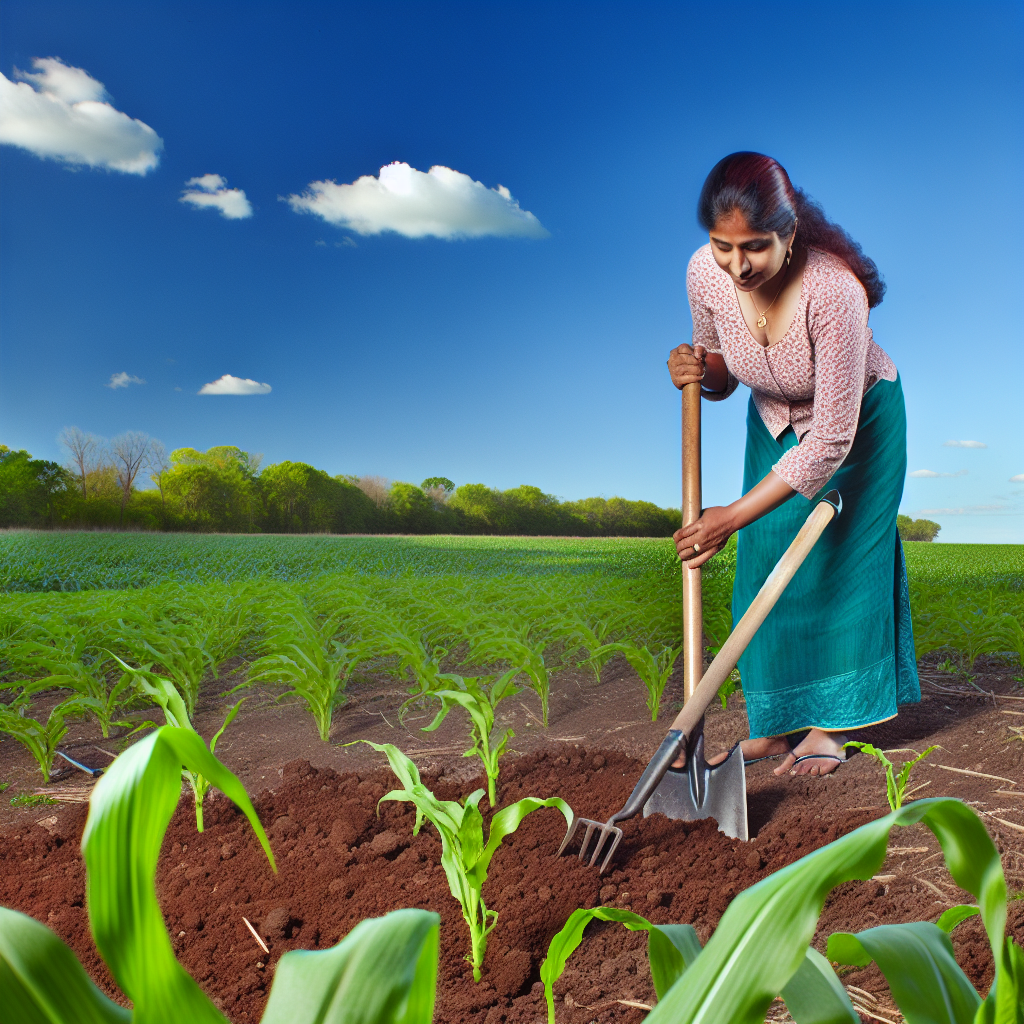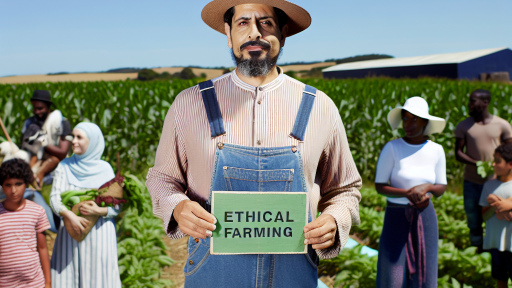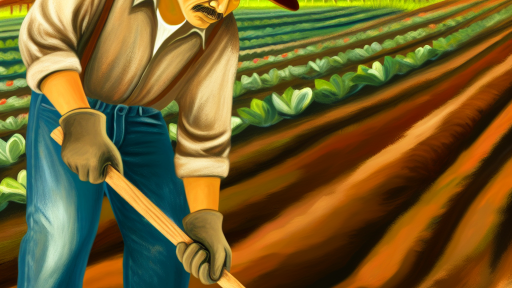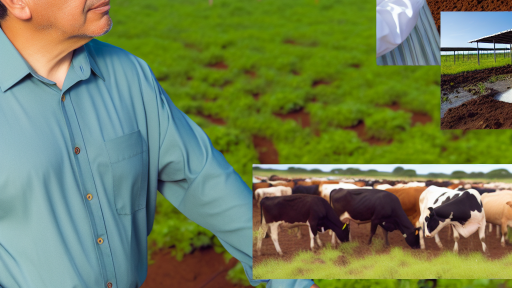Introduction to Sustainable Soil Management
Importance of Sustainable Soil Management
Sustainable soil management plays a critical role in agriculture.
It enhances soil health, fertility, and biodiversity.
This practice reduces the negative impact of farming techniques.
Consequently, it supports the long-term viability of agricultural systems.
Benefits of Sustainable Soil Management
Integrating sustainable practices provides multiple benefits.
First, it increases soil organic matter and nutrient cycling.
This improvement boosts crop productivity and food security.
Next, sustainable soil management helps mitigate climate change effects.
It enhances carbon sequestration, reducing greenhouse gases.
Additionally, it improves water retention and reduces erosion.
Farmers can decrease input costs by relying on natural processes.
Ultimately, sustainable soil management fosters healthier ecosystems.
Transitioning to Sustainable Practices
Farmers can adopt various practices to transition effectively.
Cover cropping is one approach that protects the soil.
Crop rotation improves nutrient balance and pest control.
Transform Your Agribusiness
Unlock your farm's potential with expert advice tailored to your needs. Get actionable steps that drive real results.
Get StartedAdditionally, reduced tillage preserves soil structure.
Composting boosts organic matter and soil fertility.
Farmers can also utilize agroforestry techniques for better results.
Overall, these methods contribute to sustainable land use.
Key Principles of Sustainable Soil Management Practices
Soil Health Enhancement
Sustainable soil management focuses on enhancing soil health.
This includes promoting soil organic matter and nutrient availability.
Healthy soils support robust plant growth and productivity.
Additionally, they improve water retention and biodiversity.
Erosion Control
Implementing erosion control techniques is essential in sustainable practices.
Cover crops and mulching are effective methods to reduce soil erosion.
These practices shield the soil from wind and water damage.
Moreover, they help maintain soil structure and fertility.
Crop Rotation Techniques
Crop rotation promotes sustainable soil management and practices.
This technique helps prevent nutrient depletion in the soil.
Rotating crops also interrupts pest and disease cycles.
As a result, it enhances biodiversity and soil resilience.
Minimizing Soil Disturbance
Minimizing soil disturbance is a fundamental principle of sustainable practices.
Conservation tillage methods reduce soil disruption.
These methods protect soil structure and microbial life.
Moreover, they improve carbon sequestration in the soil.
Water Management Strategies
Effective water management helps sustain healthy soil systems.
Irrigation practices should aim for efficiency and minimal runoff.
Implementing rainwater harvesting can enhance water conservation.
This supports both crop growth and soil moisture levels.
Showcase Your Farming Business
Publish your professional farming services profile on our blog for a one-time fee of $200 and reach a dedicated audience of farmers and agribusiness owners.
Publish Your ProfileUse of Organic Amendments
Using organic amendments enriches the soil and promotes sustainability.
Compost and green manures enhance soil fertility naturally.
These amendments improve soil structure and microbial activity.
Furthermore, they help retain moisture and suppress weeds.
Soil Health Assessment
Importance of Soil Health Assessment
Soil health assessment is crucial for sustainable agriculture.
This process helps farmers understand soil conditions.
Moreover, it guides the selection of appropriate management practices.
Techniques for Soil Health Assessment
Several techniques exist to assess soil health effectively.
One common method involves visual inspections of the soil.
Farmers should observe soil color, texture, and structure.
Additionally, soil sampling provides valuable data.
Laboratory analysis of soil samples reveals nutrient levels.
Tools to Aid in Soil Assessment
Various tools enhance the efficiency of soil assessments.
pH meters measure soil acidity or alkalinity accurately.
Soil moisture sensors monitor water levels in the soil.
Moreover, digital soil maps offer comprehensive insights.
- GPS devices help locate sampling areas precisely.
- Handheld soil test kits allow on-site analysis.
- Remote sensing technology identifies soil variability.
Integrating Soil Assessment Results
Integrating assessment results into farming practices is essential.
Farmers should adjust their practices based on findings.
For instance, if nutrient levels are low, they can apply fertilizers.
Moreover, they can implement cover cropping to enhance soil organic matter.
Regular assessments ensure sustainable soil management over time.
Delve into the Subject: Starting Your Own Community Supported Agriculture
Organic Amendments: Utilization of Compost and Manure
Importance of Organic Amendments
Organic amendments play a crucial role in sustainable soil management.
They enhance soil structure and increase nutrient availability.
Moreover, they improve soil moisture retention.
Using organic materials benefits microbial activity significantly.
Compost as an Organic Amendment
Compost is a versatile organic amendment.
It enriches soil with essential nutrients.
Additionally, compost helps in suppressing soil-borne diseases.
It also promotes healthy root development in plants.
How to Make Compost
Creating compost involves collecting organic waste materials.
Common ingredients include kitchen scraps, yard waste, and leaves.
Maintaining a balanced mix of carbon and nitrogen is essential.
Aeration is also critical for the composting process.
Using Compost Effectively
Apply compost at the beginning of the growing season.
Incorporate it into the topsoil for maximum effectiveness.
Regular applications enhance soil health over time.
Manure as an Organic Amendment
Manure is another valuable organic amendment.
It provides high levels of nutrients for plants.
Properly aged manure minimizes the risk of pathogen contamination.
Showcase Your Farming Business
Publish your professional farming services profile on our blog for a one-time fee of $200 and reach a dedicated audience of farmers and agribusiness owners.
Publish Your ProfileThis organic material enhances soil fertility tremendously.
Types of Manure
Common types of manure include cow, chicken, and horse manure.
Each type has unique nutrient profiles beneficial for crops.
Applying Manure for Best Results
Apply manure during fall or early spring for best results.
Incorporate it into the soil to reduce nutrient runoff.
Always test manure for nutrient content before application.
Gain More Insights: Creating a Subscription Box for Farm Products
Cover Cropping: Benefits and Best Practices
Understanding Cover Crops
Cover crops are plants grown primarily to benefit the soil.
They are not harvested for food but serve several important functions.
Farmers use them to protect and improve soil health.
Moreover, they prevent erosion during off-seasons.
Benefits of Cover Cropping
Cover cropping offers numerous benefits for sustainable soil management.
Firstly, they enhance soil structure and fertility.
This leads to better water retention in the soil.
Additionally, cover crops increase organic matter content.
Furthermore, they help suppress weeds effectively.
This reduces the need for chemical herbicides.
Best Practices for Implementing Cover Crops
Adopting cover crops requires a thoughtful approach.
Select cover crops appropriate for your region and soil type.
Legumes are excellent for nitrogen fixation.
Grasses are beneficial for soil structure enhancement.
Next, plan the timing for planting and termination wisely.
This timing maximizes benefits while minimizing competition with cash crops.
Choosing the Right Species
Selecting the right species is crucial for achieving desired results.
- Consider local climate conditions and soil types.
- Choose species that complement your primary crops.
- Mixing species can provide diverse benefits.
Evaluation and Monitoring
Evaluating the impact of cover crops is important.
Monitor soil health and fertility changes over time.
Adjust your strategies based on observed results.
Regular assessments aid in optimizing your cover cropping system.
Find Out More: Ethical Animal Farming Challenges
Crop Rotation: Enhancing Soil Fertility and Reducing Pest Pressure
The Benefits of Crop Rotation
Crop rotation significantly improves soil fertility.
It prevents nutrient depletion caused by growing the same crops repeatedly.
Moreover, diverse crops contribute to a balanced nutrient profile in the soil.
Farmers can reduce reliance on synthetic fertilizers.
This practice ultimately leads to healthier crops and soil ecosystems.
Reducing Pest and Disease Pressure
Crop rotation disrupts pest life cycles effectively.
By alternating crops, pests struggle to adapt to changing environments.
Diverse plant varieties also foster beneficial insects and organisms.
This natural pest control method minimizes chemical pesticide use.
Consequently, it promotes a healthier agricultural ecosystem.
Implementation Strategies for Effective Crop Rotation
Planning a successful crop rotation requires careful consideration.
Showcase Your Farming Business
Publish your professional farming services profile on our blog for a one-time fee of $200 and reach a dedicated audience of farmers and agribusiness owners.
Publish Your ProfileFarmers should assess soil conditions and past crop performances.
Choosing complementary crops maximizes benefits for soil health.
For instance, pairing legumes with cereals nourishes the soil with nitrogen.
Many farmers find that keeping records of crop sequences improves results.
Common Crop Rotation Patterns
Several effective crop rotation patterns exist.
- Alternating between legumes and grasses enhances nitrogen levels.
- Integrating cover crops protects soil during off-seasons.
- Rotating root crops with leafy greens optimizes nutrient absorption.
These patterns contribute to sustainable farming practices and better yields.
Challenges and Considerations
Despite its benefits, implementing crop rotation can be challenging.
Farmers must consider market demand for different crops.
This practice may require additional planning and management efforts.
Furthermore, some crops may not thrive in every environment.
Thus, farmers should adapt their practices to local conditions.
Find Out More: Overcoming Challenges in Farm-to-School Programs

Conservation Tillage Techniques for Minimizing Soil Disturbance
Defining Conservation Tillage
Conservation tillage is a farming practice that reduces soil disturbance.
This technique maintains soil structure and health.
Farmers use various methods to minimize their impact on the soil environment.
Benefits of Conservation Tillage
Adopting conservation tillage offers numerous advantages for farmers.
Firstly, it enhances soil moisture retention, which is crucial during dry seasons.
Secondly, it increases organic matter content, improving soil fertility.
Additionally, conservation tillage helps reduce erosion and runoff.
Techniques to Implement Conservation Tillage
Farmers can employ several techniques to effectively practice conservation tillage.
No-till farming is one popular method.
This technique involves planting directly into undisturbed soil.
Another option is strip-tillage, where only certain areas are tilled.
Cover cropping serves as another important practice here.
This involves growing specific crops to protect and enrich the soil.
Choosing the Right Implementation Method
Effective implementation begins with selecting the right methods for your farm.
Start by assessing soil type, crop requirements, and climatic conditions.
Consulting with agricultural experts aids in making informed decisions.
It’s also wise to evaluate the economic benefits of each technique.
Monitoring and Adaptation
Continuous monitoring is vital for the success of conservation tillage.
Farmers should regularly evaluate soil health and crop performance.
If necessary, adapting techniques can enhance long-term outcomes.
Finally, sharing knowledge and experiences with fellow farmers can foster improvement.
Integrated Pest Management (IPM): Reducing Chemical Dependence
Understanding IPM
Integrated Pest Management (IPM) combines different strategies to manage pests effectively.
This approach minimizes the reliance on chemical pesticides.
It focuses on long-term prevention and control of pests.
Furthermore, IPM promotes ecological balance and sustainability.
Key Components of IPM
IPM utilizes a variety of techniques to manage pest populations.
These techniques include biological control, cultural practices, and mechanical control.
- Biological control involves using natural enemies of pests.
- Cultural practices focus on changing farming practices to reduce pest pressure.
- Mechanical control uses physical methods to manage pests.
Each component plays a crucial role in reducing chemical usage.
Showcase Your Farming Business
Publish your professional farming services profile on our blog for a one-time fee of $200 and reach a dedicated audience of farmers and agribusiness owners.
Publish Your ProfileBenefits of IPM
Adopting IPM provides numerous benefits for farmers and the environment.
First, it enhances biodiversity by promoting beneficial species.
Second, it reduces the chemical load in ecosystems.
This leads to healthier soils and water systems.
Moreover, IPM can save farmers money by reducing pesticide costs.
Implementing IPM
To implement IPM, farmers must first assess their pest situations.
They should monitor pest populations and identify thresholds for action.
Next, they evaluate available management options.
This evaluation helps in selecting the most effective strategies.
Successful implementation requires patience and ongoing education.
Water Management Strategies: Preventing Erosion and Enhancing Soil Structure
Importance of Water Management
Water management plays a critical role in agriculture.
It affects soil health and crop productivity directly.
Effective strategies improve water retention in the soil.
This ultimately prevents erosion and enhances soil structure.
Implementing Erosion Control Measures
Farmers can adopt various erosion control measures.
Cover crops are a proven method to prevent soil loss.
They protect the soil with their roots and canopy.
Additionally, planting trees along fields helps as well.
These trees slow down water runoff and stabilize the soil.
Practices for Enhancing Soil Structure
Improving soil structure enhances water infiltration.
One effective practice is the use of organic matter.
Additions like compost or manure improve soil texture.
Furthermore, minimal tillage reduces soil compaction.
This method allows for better root development and water absorption.
Creating Swales and Contours
Farmers can design swales to manage excess water.
Swales are shallow trenches that redirect water flow.
They help slow down runoff and promote groundwater recharge.
Similarly, contour farming is useful for sloping fields.
This technique uses natural land contours to reduce erosion.
Incorporating Rainwater Harvesting
Rainwater harvesting is an efficient water management strategy.
This method captures and stores rainwater for dry days.
It provides supplemental irrigation when needed.
Additionally, it reduces reliance on traditional water sources.
Farmers can create cisterns or use barrels for storage.
Utilizing Technology and Monitoring
Modern technology enhances water management strategies.
Sensors can monitor soil moisture levels accurately.
This data helps farmers make informed irrigation decisions.
Drones can assist in assessing crop health as well.
Overall, technology streamlines the management process significantly.
Community Involvement: Educating and Engaging Stakeholders in Sustainable Practices
The Role of Community in Sustainable Soil Management
The community plays a crucial role in sustainable soil management.
Showcase Your Farming Business
Publish your professional farming services profile on our blog for a one-time fee of $200 and reach a dedicated audience of farmers and agribusiness owners.
Publish Your ProfileActive participation involves local farmers, residents, and organizations.
They can work together to create awareness of sustainable practices.
Essentially, collaboration fosters a shared responsibility towards soil health.
Education Programs for Stakeholders
Education is vital for engaging stakeholders in sustainable practices.
Workshops and seminars can provide valuable insights into soil management.
For instance, local agricultural extension services can organize events.
These programs can cover topics such as composting and cover cropping.
Furthermore, schools can incorporate soil health education into their curricula.
Community Workshops and Training Sessions
Hands-on workshops encourage active learning among community members.
Participants can learn techniques for soil conservation directly.
For example, demonstrations on no-till farming can greatly benefit local farmers.
This approach enhances practical knowledge while building community ties.
Partnerships with Local Organizations
Local organizations can play a significant role in promoting sustainable practices.
Partnerships can help amplify community outreach efforts.
Nonprofits focused on environmental sustainability can offer resources and expertise.
Collaboration with academic institutions can further strengthen initiatives.
Utilizing Social Media for Awareness
Social media serves as a powerful tool for spreading awareness.
Communities can share success stories and best practices online.
Engaging content can inspire others to adopt sustainable practices.
Additionally, online platforms can facilitate discussions and resource sharing.
Creating Incentives for Sustainable Practices
Incentives can motivate stakeholders to adopt sustainable techniques.
Local governments can provide grants or subsidies to enthusiastic participants.
This approach encourages experimentation with innovative practices.
Furthermore, recognition programs can highlight successful efforts in the community.
Additional Resources
What is Sustainable Agriculture? | Union of Concerned Scientists
Farm to Table: Building Local and Regional Food Systems – SARE




